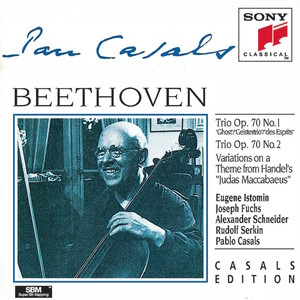
Ludwig van Beethoven (1770-1827)
Piano Trio in D major, Op. 70 No. 1, Ghost Trio (1808)
Piano Trio in E flat major, Op. 70 No. 2 (1808)
Twelve Variations on a Theme from Handel’s Judas Maccabeus, WoO 45 (1796)
Pablo Casals (cello)
Eugene Istomin (piano: trios)
Rudolf Serkin (piano: Variations)
Joseph Fuchs (violin, Op. 70 No. 1)
Alexander Schneider (violin, Op. 70 No. 2)
rec. July 1953, Prades, Spain (Ghost), August 1951, Perpignan, France (others)
Presto CD
Sony Classical SMK58991 [71]
Beethoven was known to be fond of composing pairs of works of strongly contrasting character. The two piano trios Op. 70 are an excellent example.
The so-called Ghost Trio is the highlight here – an inspired performance. Right at the beginning, the players capture the essential impetuous character: four bars of fortissimo, then (as in the Eroica Symphony) a sudden foreign note, a sustained F natural. I love this rugged interpretation because the Allegro vivace e con brio includes a lot of fierce music, with an especially intense development section. On the other hand, the many dolce phrases sound beautifully tender, and the players ideally evoke the pianissimo serenity of the coda (until the late crescendo).
The D minor movement Largo assai ed espressivo is one of the slowest in Beethoven’s entire output, but it still needs the feeling of pulse, and that fortunately is sustained here. The extraordinary rumblings in the piano left hand inspired the work’s nickname (thank you, Carl Czerny), but the whole movement has a mysterious, spell-binding atmosphere. The tempo is Largo assai, but the strait-jacketed or funereal is best avoided, as it has been in this performance. At the other extreme, the finale is a Presto of sunny aspect. Eugene Istomin executes the quaver passage-work with brilliant flair. All three musicians sound as though they are enjoying themselves, not least in the witty pizzicato passage towards the end.
I would place the performance of the E flat Trio on a lower level. One of my personal favourites among Beethoven’s slightly less well-known works, the piece is genial, relaxed and graceful; Angus Watson aptly described it as ‘spiritually at peace with itself’. His personal tragedies notwithstanding, Beethoven often inhabited such sunny territory, proving that his life and his music – as perhaps most composers’ – ran on separate tracks.
The first performance which sticks in my mind was by the Stern-Rose-Istomin Trio. I was delighted by the sheer happiness and conviviality of their music-making. The Schneider-Casals-Istomin Trio do not achieve the same buoyancy. They come across as more studied and a little too serious. On the positive side, I like their transition from the initial Poco sostenuto into the main Allegro non troppo. The latter’s tempo is a shade under what I would consider ideal, but this is not the reason for any shortcomings. To me, the essential character of a work or movement cannot be only attributed to the chosen tempo. The Stern-Rose-Istomin Trio play with a wonderful lightness and relaxation.
Let me illustrate the difference with the change to C minor in the second movement. I usually like it that Pablo Casals is gruff in Beethoven, but here he and his colleagues are rather too aggressive in one of the composer’s most individual works. I prefer the grace and naturalness of Stern and partners. Also, in this performance the Scotch snaps are played in a more clipped, less lyrical manner. These relatively minor points are typical of the overall approach.
The third movement is, very unusually, the second of two Allegrettos. This in itself indicates the generally relaxed character of the piece. Arguably, the Schneider-Casals-Istomin Trio find more mystery here (the little ‘sighing’ phrase which first appears in bars 88-90). This is valid but I am not convinced that it is inherent in the music. The magnificent finale gets a very fine performance, but again this is quite serious, even a shade severe at times, whereas Stern and company convey more joie de vivre and warmth.
Rudolf Serkin joins Casals in the Judas Maccabeus Variations. Beethoven was deeply impressed by a Berlin performance of the oratorio in 1794, and maintained a high regard for Handel (‘the greatest composer that ever lived’). This is a big, forthright performance. I am a passionate admirer of Casals’s musicianship but his intermittent groaning may distract. Have record producers through the ages been frightened of upsetting the many soloists and especially conductors who have been guilty of this self-indulgent habit?
The booklet has interesting material about the musicians and two photographs of Casals (young and much older), but nothing on the music itself. The recordings are over 70 years old, but stand up very well.
Philip Borg-Wheeler
Help us financially by purchasing from



















